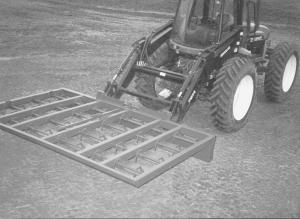2001 - Volume #25, Issue #6, Page #04
[ Sample Stories From This Issue | List of All Stories In This Issue | Print this story
| Read this issue]
Home-Built 20-Bale Fork Saves Time and Money
 |
Even though his Hoelscher bale accumulator lays bales out in packs of 10 in the field, he figured he'd save a lot of time if he could handle 20 bales at once when unloading and stacking them.
He'd used both Hoelscher and Hesston 10-bale forks and liked the way they worked, so his first attempt at building a 20-bale fork was to put two forks together. "It just wasn't heavy enough to handle the weight of that many bales," he says.
Schmidt decided to make his own 20-bale fork, designed on the same principal as the 10-bale Hoelscher fork but with a much heavier frame. His frame is 3 by 6-in. steel tubing on three sides, with a lighter 2 by 4 tube on the fourth or front - side. He used 3 by 6-in. tubing for five cross supports, through which pass 1 1/2-in. square tubing shafts that are fitted with four rows of fork teeth.
To further stabilize the fork, Schmidt ran three 12-in. wide, 1/8-in. thick lengths of flat iron from one end to the other. The fork shafts are all linked together so all the teeth open or close at the same time using only one hydraulic cylinder.
He made a quick-tach hitch for the bale mover, so he can use it on either his New Holland TR 140 Bi-Directional or his Allis 8050 front wheel assist.
"When we were building it, we intended to use Hoelscher teeth on it," he says. "Those are about $20 each and we needed 40 of them."
Rather than spend $800 for teeth, Schmidt decided to make his own by putting together two pieces of 1/4-in. flat iron and then adding a 7-in. length of round bar cut from old dump rake teeth at the end, so they look sort of like a C. "I cut the dump rake teeth at an angle so the ends would be pointed," he says. "I was able to cut four 7-in. pieces from one rake tooth, so I used 10 dump rake teeth in making this."
Schmidt figures the 20-bale fork cut his unloading and stacking time by more than half. Because he made it himself, he figures it cost only about $1,900.
"Now that I've made one and used it all summer without any problems, I'd be willing to make a few more for others who are interested. If I were making them, though, I'd probably want to use the Hoelscher teeth. Making the teeth was the hardest and most time-consuming part of building it," he says.
Contact: FARM SHOW Followup, Brian Schmidt, 1400 South Marion Road, Apt. 116, Sioux Falls, S. Dak. 57106 (ph 605 323-2323).

Click here to download page story appeared in.

Click here to read entire issue
To read the rest of this story, download this issue below or click here to register with your account number.




